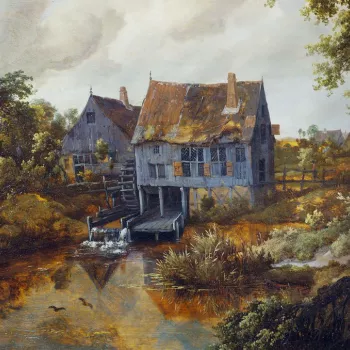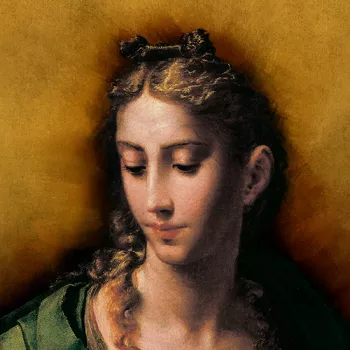The Hayfield c.1660-68
Oil on canvas | 66.9 x 79.1 cm (support, canvas/panel/stretcher external) | RCIN 405334
-
Philips Wouwermans (1619-68) spent his life in Haarlem, though briefly visiting Hamburg in 1638 or 1639. Wouwermans’s early work is reminiscent of that of Isaac van Ostade and the influence of the Haarlem tonal school persists throughout his career in effects of soft light filtered through misty skies and in the thinly painted areas allowing brown underpaint to show through. His later work has bluer skies, and a more silvery overall tonality as well as including more elegant figures.
Though a harvesting scene, the first group we pick out in this painting are the outsiders – the hunters picking their way past a blind beggar on a narrow path, as if about to meet us (the viewer) coming in the opposite direction. One man holds a falcon and a clutch of dogs to retrieve any hunted birds; the other man leans a ‘lure-pole’ against his shoulder (this is a long pole on the end of which is attached some bait to persuade the bird to return to the arm). The mowers are working as long as daylight lasts, piling up the hay, loading it into carts and a barge on the canal to the left. The waterman is bathing to remind us how hot it is to work in the sun, an idea also conveyed by the even warm grey tonality, suggestive of the dusty heat of the harvest. Three women take a break from work and attempt to stuff hay up each other’s dresses, watched by a boy with a satchel.
As the compiler of the 1819 inventory of Carlton House pointed out, this is painted in Wouwermans’s finished technique and with the ‘silvery’ tonality characteristic of his later work, features that evidently justified its astonishing valuation of 800 guineas. In spite of this precious air, the composition and narrow colour range is still reminiscent of the tonal school and in particular of the work of Isaac van Ostade. Wouwermans has imitated Ostade’s tendency to rhyme or homogenise the forms and patterns of the landscape – the thatch of the cottages with the hayricks, the broad backs of the men with the rumps of the horses – as if long habit has made men and their creations seem part of the landscape.
Signed lower right corner: 'PHILS. [in monogram] W'Provenance
Acquired by George IV in 1811; recorded in the Rose Satin Room at Carlton House in 1819 (no 24); in the Picture Gallery at Buckingham Palace in 1841 (no 156)
-
Medium and techniques
Oil on canvas
Measurements
66.9 x 79.1 cm (support, canvas/panel/stretcher external)
89.1 x 101.8 x 8.0 cm (frame, external)
Other number(s)










